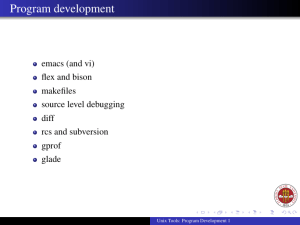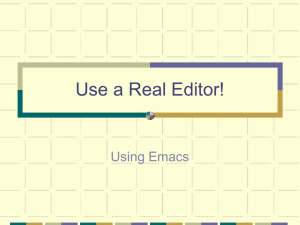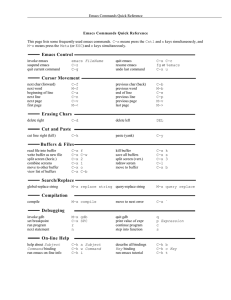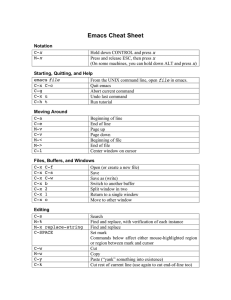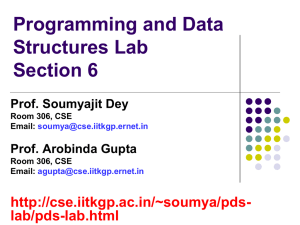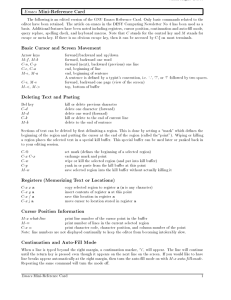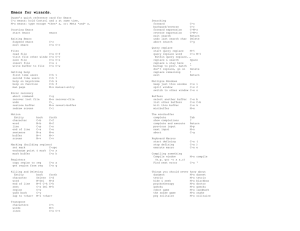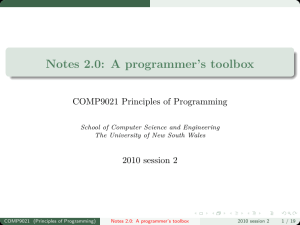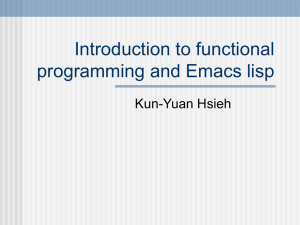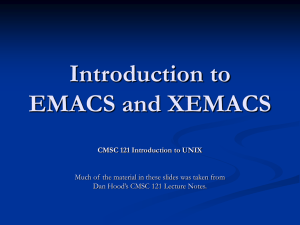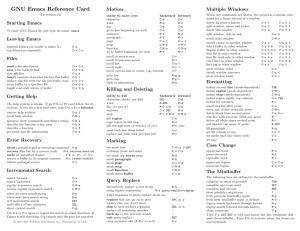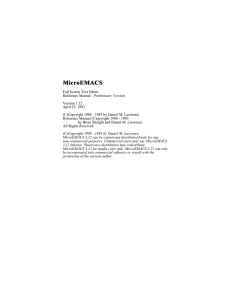emacs - 國立臺灣大學數學系
advertisement
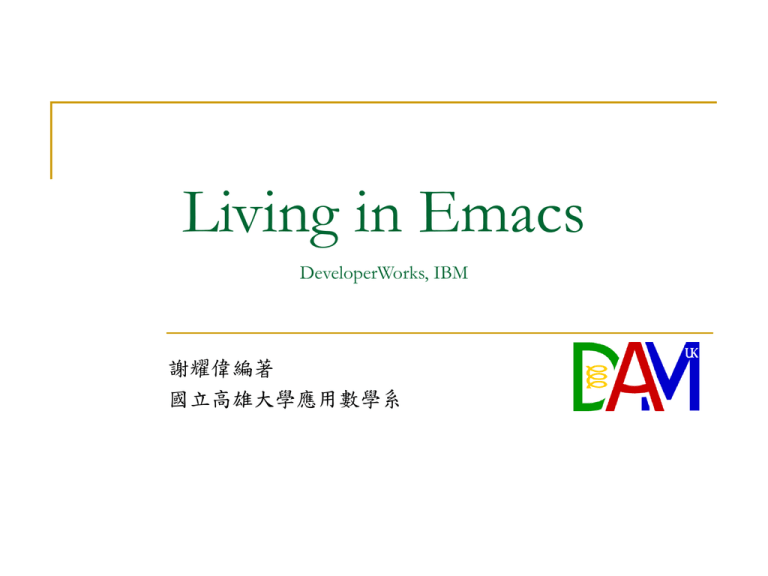
Living in Emacs DeveloperWorks, IBM 謝耀偉編著 國立高雄大學應用數學系 What is Emacs? Emacs is the extensible, customizable, selfdocumenting real-time display editor. Emacs can do so very many different things so well that it would make a fine operating system. Living in Emacs (2004年8月) 高大應數課程講義 2 The Emacs view Menu Editing windows Mouse-enabled scroll bar Status bar Living in Emacs (2004年8月) Mini buffer 高大應數課程講義 3 Emacs keystroke conventions C-<chr> == Control + character, pressed at the same time. M-<chr> == Meta + character, pressed at the same time. p.s. Meta might be the Alt key, or the Esc key Living in Emacs (2004年8月) 高大應數課程講義 4 Commands and key-bindings Emacs implements a version of LISP to build its commands and extensions. All commands have names, like Buffermenu-bury, backward-char. Many of the commands are bound to key combinations, prefaced with the Control and Meta keys. Living in Emacs (2004年8月) 高大應數課程講義 5 First instructions C-x C-c :Quit the Emacs C-x C-f :open a file C-x C-s:save my work and continue typing C-x C-w: save as Living in Emacs (2004年8月) 高大應數課程講義 6 Emacs cut and paste C-d: deletes the character under the cursor M-d: kill-word M-Delete: backward-kill-word M-k: kill-sentence C-x: Delete backward-kill-sentence C-k: kill-line C-y : yank the most recent block Living in Emacs (2004年8月) 高大應數課程講義 7 The universal argument C-u: universal-argument.It can be used as a prefix for a great number of other actions Ex:type C-u 6 C-k kills three lines. Living in Emacs (2004年8月) 高大應數課程講義 8 Basic operations in review Key-binding Action (command) C-g (Esc Esc Esc) keyboard-quit to get out of a command that's been started Backspace Delete (C-d) C-x u (C-_) M-d M-Delete Living in Emacs (2004年8月) backward-delete-char delete-char advertised-undo kill-word backward-kill-word 高大應數課程講義 9 Basic operations in review (conti.) Key-binding Action (command) M-k kill-sentence C-x Delete backward-kill-sentence C-k kill-line C-y yank is the paste equivalent M-y Traverse the kill ring, must follow C-y C-u, C-u N universal-argument, adds count prefix to commands Living in Emacs (2004年8月) 高大應數課程講義 10 Little steps Living in Emacs (2004年8月) C-f advances the cursor one character C-b moves it back one character C-n moves to the next line C-p moves the cursor up one line 高大應數課程講義 11 Words, lines, and sentences Living in Emacs (2004年8月) C-a takes you to the first column in the current line C-e takes you to the line's end M-b moves back one word M-f moves the cursor forward one word M-a takes us backward to the beginning of the current sentence M-e moves forward in the same manner, relative to sentence ends 高大應數課程講義 12 Taking big steps Living in Emacs (2004年8月) C-v scrolls the text forward one screen M-v scrolls the text backward one screen C-l re-centers the window around the current cursor location 高大應數課程講義 13 Incremental searches C-s: isearch-forward C-r : isearch-backward Living in Emacs (2004年8月) 高大應數課程講義 14 Regexp searches ESC C-s: start a forward regexp search ESC C-r: start a backwards regexp search Ex:I have the words bartok and footok someplace in my text. I want to find the closest instance of either one. ESC C-r bar\|foo Living in Emacs (2004年8月) 高大應數課程講義 15 Replacing text M-X replace-string: This is followed by the target string/expression and the replacement string. Replacement is unconditional and forward from the cursor location only. M-%: query-replace Living in Emacs (2004年8月) 高大應數課程講義 16 Windows in Emacs C-x 2: split them horizontally C-x 3: split them vertically C-x o: switch between visible windows C-x 1: maximize the window that currently contains the cursor and close other windows. Living in Emacs (2004年8月) 高大應數課程講義 17 Buffers in action Type C-x C-b. Your listing should resemble this: MR Buffer -- -----.* practice1.txt test2.txt test1.txt * *scratch* * *Messages* Living in Emacs (2004年8月) Size ---490 1 0 191 501 Mode File ------Text ~/practice1.txt Text ~/test2.txt Text ~/test1.txt Lisp Interaction Fundamental 高大應數課程講義 18 Buffers in action (conti.) The MR column reflects the "Modified" and "Read-Only" status of each buffer. Buffer (name), Size and File are selfexplanatory. Switch to the buffer listing window (using C-x o), and press Enter to select it. Living in Emacs (2004年8月) 高大應數課程講義 19 More about buffers C-x b: get a prompt in the mini-buffer, and then type the name of the destination buffer Press Enter to open that buffer in the current window. C-x k: kill the current buffer Living in Emacs (2004年8月) 高大應數課程講義 20 Modes Modes are the methods by which Emacs features are expressed in the context of specific types of content. That is, indenting behaves differently in a C source code file than in an HTML file or in a letter to your boss. There are two different types of modes: major and minor. Living in Emacs (2004年8月) 高大應數課程講義 21 Modes (conti.) M-x valid mode name:set the mode of a buffer Ex:If I open a file named bob.txt, the buffer will open in text-mode. To start working in c-mode, I can type this: M-x c-mode Living in Emacs (2004年8月) 高大應數課程講義 22 Compiling code Type M-x compile and the prompt in the mini-buffer reads, Compile command: Type in gcc -o hello hello.c To see if my program works, I'll run it from inside Emacs: M-! ~/hello. There in the mini-buffer is my output: Hello, World! Living in Emacs (2004年8月) 高大應數課程講義 23 Connectivity in Emacs C-x m: start a new e-mail message M-x browse-url-lynx-emacs: invoke Lynx, enter the URL Living in Emacs (2004年8月) 高大應數課程講義 24
